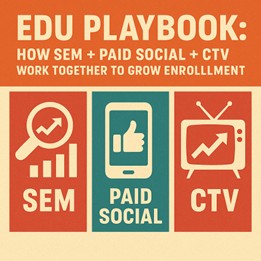In today’s digital world, schools, colleges, and educational organizations face increasing competition to attract students and remain relevant. Traditional advertising methods like print, radio, and TV have largely given way to digital approaches that can be both more affordable and more effective in reaching the right audiences. Among these, paid social advertising has become a critical tool for educational institutions seeking to enhance their visibility, grow enrollment, and engage with current and prospective students.
Here’s why paid social advertising is essential for education and how it can transform outreach efforts for schools and universities.
1. Targeting the Right Audience
Paid social ads allow educational institutions to focus on specific audiences based on demographic factors like age, location, interests, and behaviors. Platforms like Facebook, Instagram, and LinkedIn provide tools to narrow down audiences by criteria that matter most for schools, such as age group, education level, career interests, and even proximity to the campus.
For example, a school looking to boost enrollments in a specialized program, like welding engineering, can use paid ads to target students who have expressed interest in related topics such as metal types or forging. This level of precision targeting is far more effective than blanket ads in newspapers or billboards, where the reach is broad but often irrelevant.
2. Increasing Enrollment and Applications
One of the primary goals of paid social ads is to drive enrollment conversions, which in the context of education could mean applications, event registrations, or requests for more information. Social media platforms provide tools like lead generation forms and direct links to application pages, making it easier than ever for prospective students to take the next step.
In a competitive field like higher education, where students have many choices, institutions can stand out by delivering timely, relevant ads during crucial decision-making windows. This could be particularly effective during admissions seasons or when promoting virtual open days and application deadlines. Paid social ads allow educational institutions to ensure their messaging is front and center when students are making key decisions.
3. Engaging Prospective Students Where They Spend Time
Today’s students spend a significant amount of time on social media, and it’s where they often look for information and make decisions about their future education. Platforms like Instagram, YouTube, and TikTok are especially popular among Gen Z, meaning educational institutions need to be present where these students are most active.
Paid social advertising helps institutions reach students in these virtual spaces, creating opportunities for engagement that might not occur through traditional advertising. Whether it’s a quick video showcasing campus life, testimonials from current students, or informative posts about specific programs, social ads allow institutions to meet prospective students on their turf and create meaningful connections.
4. Promoting Brand Awareness and Reputation
Building a strong brand is vital for educational institutions that want to stand out in a crowded market. Paid social ads can help reinforce an institution’s reputation and distinguish it from others. Through visually appealing and informative ads, schools can communicate what makes their programs unique, highlight student success stories, and showcase their values and culture.
Campaigns that focus on achievements, faculty expertise, or the institution’s impact on the community can not only attract prospective students but also solidify the trust of parents, alumni, and industry partners. A consistent presence on social platforms through paid ads enhances credibility and keeps the institution top-of-mind for future students.
5. Measurable ROI and Data-Driven Insights
One of the major advantages of paid social advertising over traditional marketing is the ability to track and measure performance in real-time. Social media platforms provide robust analytics tools that allow educational institutions to see exactly how their ads are performing in terms of reach, engagement, and conversions.
This data-driven approach means that campaigns can be optimized continuously. If a particular ad isn’t performing well, it can be adjusted or replaced with something more effective. This adaptability ensures that marketing budgets are spent efficiently and that institutions can achieve a higher return on investment (ROI) compared to less measurable forms of advertising.
6. Leveraging Different Ad Formats for Higher Engagement
Social media platforms offer a variety of ad formats that can cater to different goals and audiences. Educational institutions can use video ads to give virtual campus tours, carousel ads to showcase multiple programs or student experiences, and story ads to create more interactive and immersive experiences.
The diversity of ad formats allows schools and universities to be creative with their messaging and better engage students. This flexibility is key when trying to capture the attention of younger audiences who are accustomed to fast-paced, visually driven content.
7. Fostering Community and Alumni Engagement
Paid social ads are not just for attracting new students—they can also be used to strengthen relationships with alumni and build a supportive community around the institution. By promoting events, alumni stories, and fundraising initiatives, institutions can use social platforms to stay connected with past graduates, which can lead to stronger alumni networks and more support for current students.
Additionally, engaging with local communities through targeted ads can help build partnerships with businesses, industries, and other educational organizations, enhancing the overall reputation and reach of the institution.
Conclusion
Paid social advertising is no longer optional for educational institutions that want to stay competitive in a fast-paced, digital-first world. From driving enrollments and building brand awareness to fostering community engagement, paid social ads provide the tools and flexibility that schools, universities, and training centers need to succeed. With the ability to target specific audiences, measure results, and adapt campaigns in real-time, paid social advertising is a powerful way for educational organizations to reach new heights in student recruitment and engagement.
As education continues to evolve, institutions that invest in digital strategies, particularly through social media, will be better positioned to thrive and meet the needs of future students.



